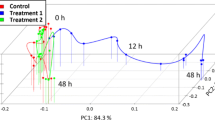Abstract
Time course gene expression experiments have proved valuable in a variety of studies. Their unique data structure and the diversity of tasks often associated with them present new challenges to statistical analysis. In this report, we give a brief review of several primary questions pertaining to such experiments and popular statistical tools to address them.
Access this chapter
Tax calculation will be finalised at checkout
Purchases are for personal use only
Similar content being viewed by others
References
Bar-Joseph, Z., Gerber, G., Gifford, D. K., Jaakkola, T. S., & Simon, I. (2003). Continous representations of time-series gene expression data. Journal of Computational Biology, 10, 341–356.
Do, K.-A., Mueller, P., & Vanucci, M. (Eds.). (2006). Bayesian inference for gene expression and proteomics. Cambridge University Press.
Diggle, P. J., Heagerty, P., Liang, K.-Y., & Zeger, S. L. (2002). Analysis of longintudinal data (2nd ed.). New York: Oxford University Press.
Edwards, M. G., Sarkar, D., Klopp, R., Morrow, J. D., Weindruch, R., & Prolla, T. A. (2003). Age-related impairment of the transcriptional response to oxidative stress in the mouse heart. Physiological Genomics, 13, 119–127.
Eisen, M. B., Spellman, P. T., Brown, P. O., & Botstein, D. (1998). Cluster analysis and display of genome-wide expression patterns. Proceedings of the National Academy of Sciences, 95, 14863–14868.
Ernst, J., Nau, G. J., & Bar-Joseph, Z. (2005). Clustering short time series gene expression data. Bioinformatics, 21, i159–i168.
Hong, F., & Li, H. (2006). Functional hierarchical models for identifying genes with different time-course expression profiles. Biometrics, 62, 534–544.
Holter, N. S., Mitra, M., Maritan, A., Cieplak, M., Banavar, J. R., & Fedoroff, N. V. (2000). Fundamental patterns underlying gene expression profiles: Simplicity from complexity. Proc. Natl. Acad. Sci. USA, 97, 8409–8414.
Ihaka, R., & Gentleman, R. (1996). R: A language for data analysis and graphics. Journal of Computational and Graphical Statistics, 5, 299–314.
Kaech, S.M., Hemby, S., Kersh, E., & Ahmed, R. (2002). Molecular and functional profiling of memory CD8 T cell differentiation. Cell, 111, 837–851.
Luan, Y., & Li, H. (2003). Clustering of time-course gene expression data using a mixed-effects model with B-splines. Bioinformatics, 19(4), 474–482.
Park, T., Yi, S. G., & Lee, S. (2003). Statistical tests for identifying differentially expressed genes in time-course microarray experiments. Bioinformatics, 19, 694–703.
Parmigiani, G., Garrett, E., Irizarry, R., & Zeger, S. (2003). The Analysis of gene expression data: Methods and software. New York: Springer Verlag.
Poland, A., & Knutson, J. C. (1982). 2,3,7,8-tetrachlorodibenzo-p-dioxin and related halogenated aromatic hydrocarbons: Examination of the mechanism of toxicity. Annual Review of Pharmacology and Toxicology, 22, 517–554.
Ramoni, M. F., Sebastiani, P., & Kohane, I. S. (2002). Cluster analysis of gene expression dynamics. Proceedings of the National Academy of Sciences, 99, 9121–9126.
Schliep, A., Steinhoff, C., & Schönhuth, A. (2003). Robust inference of groups in gene expression time-courses using mixtures of HMMs. Bioinformatics, 20, i283–i289.
Spellman, P. T., Sherlock, G., Zhang, M., Iyer, V. R., Anders, K., Eisen, M. B., et al. (1998). Comprehensive identification of cell-cycle regulated genes of the yeast saccharomyces cerevisiae by microarray hybridization. Molecular Biology of the Cell, 9, 3273–3297.
Storey, J. D., Xuai, W., Leek, J. T., Tompkins, R. G., & Davis, R. W. (2005). Significance analysis of time course microarray experiments. Proceedings of the National Academy of Sciences of the United States of America, 102, 12837–12842.
Tai, Y. C., & Speed, T. P. (2006). A multivariate empirical Bayes statistic for replicated microarray time course data. Annals of Statistics, 34, 2387–2412.
Tamayo, P., Slonim, D., Mesirov, J., Zhu, Q., Kitareewan, S., Dmitrovsky, E., et al. (1999). Interpreting patterns of gene expression with self-organizing maps: Methods and application to hematopoietic differentiation. Proceedings of the National Academy of Sciences of the United States of America, 96, 2907–2912.
Tavazoie, S., Hughes, J., Campbell, M., Cho, R., & Church, G. (1999). Systematic determination of genetic network architecture. Nature Genetics, 22, 281–285.
Tu, B., Kudlicki, A., Rowicka, M., & McKnight, S. (2005). Logic of the yeast metabolic cycle: Temporal compartmentalization of cellular processes. Science, 310, 1152–1158.
Wilson, C. L., & Safe, S. (1998). Mechanisms of ligand-induced aryl hydrocarbon receptor mediated biochemical and toxic responses. Toxicologic Pathology, 26, 657–671.
Wu, H., Yuan, M., Kaech, S., & Halloran, M. (2007). A statistical analysis of memory CD8 T cell differentiation: An application of a hierarchical state space model to a short time course microarray experiment. Annals of Applied Statistics, 1(2), 442–458.
Yuan, M. (2006). Flexible temporal expression profile modelling using the Gaussian process. Computational Statistics and Data Analysis, 51, 1754–1764.
Yuan, M., & Kendziorski, C. (2006). Hidden markov modles for microarray time course data in multiple biological conditions (with discussion). Journal of the American Statistical Association, 101, 1323–1340.
Yuan, M., Kendziorski, C., Park, F., Porter, J., Hayes, K., & Bradfield, C. (2003). HMM for microarray time course data in multiple biological conditions (Technical Report # 178). Department of Biostatistics, University of Wisconsin.
Acknowledgements
This research was supported in part by NSF grants DMS-0706724 and DMS-0846234, NIH grant R01GM076274-01, and a grant from Georgia Cancer Coalition.
Author information
Authors and Affiliations
Corresponding author
Editor information
Editors and Affiliations
Rights and permissions
Copyright information
© 2011 Springer-Verlag Berlin Heidelberg
About this chapter
Cite this chapter
Ruan, L., Yuan, M. (2011). Statistical Analysis of Time Course Microarray Data. In: Lu, HS., Schölkopf, B., Zhao, H. (eds) Handbook of Statistical Bioinformatics. Springer Handbooks of Computational Statistics. Springer, Berlin, Heidelberg. https://doi.org/10.1007/978-3-642-16345-6_14
Download citation
DOI: https://doi.org/10.1007/978-3-642-16345-6_14
Published:
Publisher Name: Springer, Berlin, Heidelberg
Print ISBN: 978-3-642-16344-9
Online ISBN: 978-3-642-16345-6
eBook Packages: Mathematics and StatisticsMathematics and Statistics (R0)




